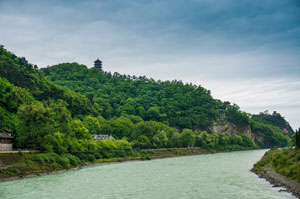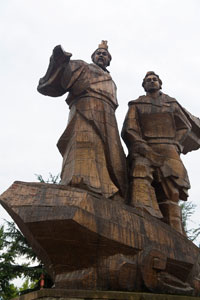Dujiangyan City is one of the places inhabited by ancestors of the Shu State in ancient China. Located in the central part of Sichuan Province, Dujiangyan is not only a cultural city with a long history, but also a famous place of interest. The Dujiangyan Irrigation System on the northwest of the city is renowned far and wide.
Around 250BC during the Warring States Period (475-221BC), Li Bing, a governor of Shu in the Qin state (present Sichuan Province) with his son directed the construction of Dujiangyan. The governor gave up the old ways of dam building which was simply try to catch the floodwaters. Instead he employed a new method by channeling and dividing the water to harness the Minjiang River. He accomplished this by separating the project in to two main parts: the headwork and the irrigation system. The project effectively put the flooding waters under control. For over two thousand years the whole system has functioned perfectly, serving as not only as flood prevention but also as an immense source for irrigation as well as a means to facilitate shipping and wood drifting. It has contributed greatly to the richness of Chengdu Plain and helps it earn its reputation as 'The Land of Abundance'.
What's more, the scenery in the area is very fascinating, and there are many key points of interest and ancient relics, making it really an ideal tourist resort. On the Yulei Mountain there is the Erwang Temple built to commemorate Li Bing and his son.
The headwork consists of three projects: Yuzui, Feishayan, Baopingkou. Yuzui is a long and narrow dyke built in the center of the Minjiang River, dividing Minjiang into the inner river and the outer. The inner river diverts water into Chengdu Plain through Baopingkou. And the outer is the main flow, which carries off 80% of silt. Feishayan is spillway for releasing flood and silt from inner river to outer river. Baopingkou is the main diversion gate to draw in water for irrigation in shape of bottleneck. In construction of irrigation system, Li Bing had a canal cut through the Yulei Mountain toward Chengdu Plain. Baopingkou marks the inlet of the man-made river. It works for conducting water and controlling the volume of inflowing water. The Dujiangyan Irrigation System receives numerous foreign tourists every year, including quite a lot of water conservancy experts, who sing highly of the scientific level of the irrigation system.
There are many historic sites in the area. The Dragon-Taming Temple is located on the top of a small hill in Dujiangyan of Sichuan Province. There are three palaces now in the temple. A stone figure of Li Bing is in the middle of the main palace. It was unearthed in 1974. This figure is made of white sandstone, wearing a hat and is dressed in a long cloth. The stone figure was made in the early years of the Emperor Lingdi of the Eastern Han Dynasty (25-220) and the earliest round carving stone figure. On the back hall is displayed an electric model of the Dujiangyan irrigation area. On the left of the temple is Baopingkou, where the water in the river surges forward and forms a majestic spectacle. A pavilion called Guanlan Pavilion is at the highest point behind the temple, from which you can see many beautiful views such as the Minjiang River.
First built in the Southern and Northern Dynasties (386-581) and named the Chongde Ancestral Temple, the temple was renamed the Erwang Temple after Li Bing and his son were appointed as kings in the Song Dynasty (960-1279). The extant buildings were rebuilt in the Qing Dynasty (1644-1911). The buildings in the temple were arranged according to the terrain of the mountain, and are magnificent and elegant.
|
|

Dujiangyan

Erwang Temple

Libing
 |

